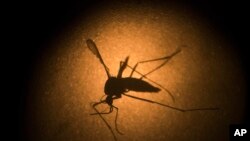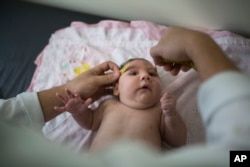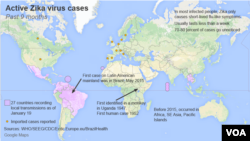The mosquito-borne Zika virus is spreading "explosively" from Brazil across the Americas, according to the World Health Organization, which on Monday declared it an international health emergency. The WHO has estimated that as many as 4 million people could be infected this year in the Americas alone.
The virus is "strongly suspected" of causing microcephaly, a disabling birth defect in which babies are born with abnormally small heads and underdeveloped brains, the WHO said. In many cases, the babies do not survive.
Zika has no known cure. Only one in five infected people experiences any symptoms, and those tend to be mild, such as headaches and joint pain, according to the U.S. Centers for Disease Control and Prevention. This has prompted an increase in health screenings and travel advisories to affected countries, particularly among pregnant women at risk of passing the virus to their children.
Dr. Beth Bell, who directs the CDC’s National Center for Emerging and Zoonotic Infectious Diseases, told VOA that health experts there and elsewhere “are doing everything we can to understand” the disease and its potential effects on the world’s population.
Mosquito-borne viruses have the capacity to spread rapidly, Bell said, "and there are some modern day factors – urbanization, large cities, international travel – that tend to promote" infectious outbreaks.
Cases in this outbreak have been reported in 25 countries. The Pan American Health Organization (PAHO) said these include two outside the Americas: Samoa and Cape Verde.
Here are answers to basic questions about the Zika virus, courtesy of Bell, the broader CDC community and the WHO.
Where did the virus originate?
Zika was discovered in 1947 in Uganda's Zika forest. Up until 2007, outbreaks were rare and narrowly confined to areas of Africa and Southeast Asia. But in the past decade, epidemics have been reported in Micronesia and Polynesia, Easter Island, the Cook Islands and New Caledonia.
The first case in South America was identified last May in Brazil. Since then, the disease has spread rapidly through most of Central and South America. Brazil’s health ministry recently reported more than 4,000 suspected cases of microcephaly since October, compared with less than 150 in all of 2014, the Associated Press reported last week.
How does the Zika virus spread?
Zika virus is spread by the Aedes mosquito, also known to cause dengue fever and chikungunya virus. The insect lives both indoors and outside, and can breed in tiny amounts of water – as little as might collect in a bottle cap.
Researchers are looking for a vaccine and a treatment. Until they’re successful, the best way to fight the disease is to combat the mosquitos that carry the virus.
Officials in Brazil and some of the 24 other countries reporting Zika cases are conducting mass spraying of pesticide and urging people to empty any containers of standing water to prevent breeding grounds for mosquitos.
Who’s at risk?
Those most vulnerable are people, especially pregnant women or those trying to become pregnant, who live or are traveling in affected areas.
The first trimester of pregnancy is the highest-risk period for infection, Bell said, citing available information on fetal brain development and on other infectious causes of congenital malformations.
What are the symptoms?
Again, these tend to be mild and flu-like: headaches, fever, joint pain, rash and red eyes. Most individuals fully recover from infection, although it can be life-threatening in extreme cases.
There is no vaccine or medical treatment currently available for Zika. The WHO and the CDC recommend rest, plenty of fluids and acetaminophen for fever and pain.
Are there any other health concerns?
The World Health Association says the virus’ arrival in Brazil also has been associated with a rise there in cases of Guillain-Barre syndrome, a rare disorder that can produce muscle weakness and even temporary paralysis. It’s not contagious.
The WHO adds that "a causal relationship between Zika virus infection and birth defects and neurological syndromes has not been established but is strongly suspected."
What can I do to reduce the risk of infection?
Avoid travel to areas where the Zika virus has been reported. Otherwise, the CDC recommends that you:
*Wear long-sleeved shirts and long pants.
*Stay in places that have air conditioning or that use window and door screens to keep out mosquitoes.
*Sleep under a mosquito bed net to protect yourself from mosquito bites.
*Use Environmental Protection Agency-registered insect repellents. Always follow label instructions and reapply as directed. Do not spray repellent on the skin under clothing.
*If you’re also using sunscreen, apply that before putting on insect repellent.
If you have a baby or child:
*Do not use insect repellent on babies younger than 2 months old. For treating older children, spray insect repellant onto your hands, then apply it to child’s face. Do NOT apply on child's hands, on cut or irritated skin, or near eyes and mouth.
*Dress your child in clothing that covers arms and legs, or cover crib, stroller and baby carrier with mosquito netting.
VOA's Carol Guensburg contributed to this report.











